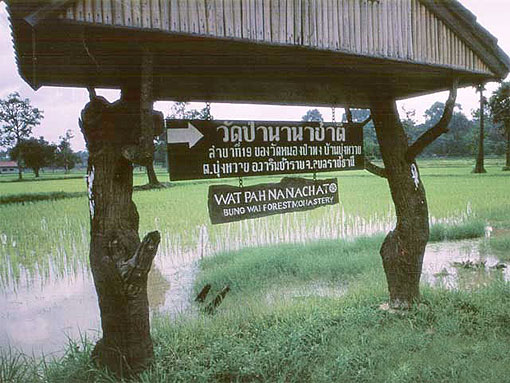- Wat Pah Nanachat
Infobox Buddhist temple
name = Wat Pah Nanachat Buddhist Monastery

|thumb|right|240px
img_size =
img_capt = Pointing the way along the path to Wat Pa Nanachat.
landscape = yes
denomination =Thai Forest Tradition
founded =
closed =
founder = Luang PorChah Subhatto
teacher =
director =
roshi =
abbot = Luang PorChah Subhatto
priest =
rinpoche =
reverend =
address = Wat Pah Nanachat Bah Bung Wai, Ampher Warin Chamrab, Ubon Ratchathani 34310,THAILAND
country =Thailand
phone =
website = [http://www.watpahnanachat.org watnanachat.org]Wat Pah Nanachat (
Thai : วัดป่านานาชาติ, The International Forest Monastery) is situated in a small forest in north-eastThailand about fifteen kilometres from the city ofUbon Rachathani . In1975 Ajahn Chah established themonastery to provide a traditional monastic training community for non-Thais. Today the community consists of monks,novices andpostulants from a wide range of nationalities. English serves as the primary language of communication and instruction. [ [http://www.watpahnanachat.org/stay.php Wat Pah Nanachat ] ]History
The monastery was founded in response to increasing international interest, particularly from the
United Kingdom , in the theravadin forest tradition of Thailand. The first abbot of Wat Pah Nanachat wasAjahn Sumedho , an Americanbhikkhu trained by Ajahn Chah atWat Nong Pah Pong , the mother house of Wat Pah Nanachat. Today, as a consequence, students of the Thai forest tradition are found in branch monasteries around the world under the collective label of "The Forest Sangha". [http://www.forestsangha.org Forest Sangha website] The largest monastery of this network is Amaravati Monastery about 30 miles north ofLondon . Its abbot is Ajahn Sumedho.Meditation
It's little exaggeration to say that Buddhist meditation practice of all sorts is encouraged at Wat Nanachat, though breathing meditation predominates. In the spirit of Ajahn Chah's teachings,
vipassanā or insight, andsamatha or concentration, are regarded as two sides of a coin rather than two distinct categories. Lay visitors are expected to observe theeight precepts version of sila, or the practice ofvirtue . For monks, strict adherence to theVinaya , the 2,500-year-old code of discipline, is not only required but is the distinguishing characteristic of the lineage. For lay visitors, no formal meditation teaching is available beyondDhamma talks and what may be derived from freely available reading matter, the priority being the formal training of the full-time mendicants.Visiting
Prospective visitors to the
Wat are advised to write well in advance, as facilities are somewhat limited. Men staying for more than a few days are required to shave their heads, as well as facial hair and eyebrows. Laypeople dress in modest white clothing, borrowed from the monastery if necessary. Some laywomen wear black skirts with a white blouse. Venerable Ajahn Kevali, abbot since 2007, encourages a more communal atmosphere than perhaps earlier had been the case. Guests are expected to take part in all daily activities. Following is a summary of a typical daily schedule:*3:00 a.m. Wakeup
*3:30 a.m. Meet in the main hall for morning chanting
*6:00 a.m. Sweeping the grounds, helping in the kitchen (laypeople), and Pindabat (Alms) for the monks
*8:00 a.m. Dana (offering food to the monks), followed by the daily meal
*3:00 p.m. Work such as getting water, cleaning, and community projects
*5:00 p.m. Meet in the Abbot's kuti for tea
*7:00 p.m. Meet in the main hall for evening chanting and a Dhamma Talk
*9:30 p.m. SleepOn Observance Days (
uposatha ), the schedule may vary somewhat as monks and laity alike struggle to sit in meditation all through the night till five in the morning.Abbots
*
Ajahn Sumedho (1975 - 1977)
*Ajahn Pabhakaro (1977 - 1979)
*Ajahn Jagaro (1979 - 1982)
*Ajahn Pasanno (1982 - 1996)
*Ajahn Jayasaro (1996 - 2002)
*Ajahn Nyanadhammo (2002 - 2007)
*Ajahn Kevali (2007 - present)Getting there
The monastery is in Isaan, the north-eastern region of Thailand, in the district or
amphoe of Warin Chamrap,Ubon Ratchathani Province,Tambon Bung Wai."To Ubon Ratchathani:" Thai Airways offers flights to Ubon from Don Mueang in
Bangkok . Overnight sleeper [ [http://www.railway.co.th/english/images/northeast.giftrain timetables] ] from Bangkok, as well as other trains and buses are available. "To Wat Pah Nanachat:" Once in Ubon, going to Wat Pah Nanachat is straightforward and there are a few options. Any buses in Ubon bound for Si Saket drive past the Wat, simply ask the driver to be let off there. Another option is to take a bus to Warin Chamrap, where you can take aSongthaew to the Wat. It's also possible to hire atuk-tuk or taxi to the wat from the airport, bus or train stations."Mailing address:" Wat Pah Nanachat, Bahn Bung Wai, Amphoe Warin Chamrap, Ubon Ratchathani 34310, Thailand (Thai:วัดป่านานาชาติบ้านบุ่งหวายอำเภอวารินชำราบจังหวัดอุบลราชธานี๓๔๓๑๐)
ee also
*
Buddhism in Thailand
*Samanera Bibliography
* "The Forest Path": talks, essays, photographs etc, Wat Pah Nanachat, 1999.
References
External links
* [http://www.watpahnanachat.org Wat Pah Nanachat website]
* [http://www.forestsangha.org Forest Sangha website]
* [http://www.thaibuddhism.net Thai Buddhism]
* [http://www.dhammathai.org/e/meditation/page17.php Meditation places in Thailand]
* [http://www.thailex.info/THAILEX/THAILEXENG/LEXICON/Religie%20&%20Mythologie%20tekst.htm#Thais%20boeddhisme Thai Theravada Buddhism]
Wikimedia Foundation. 2010.
